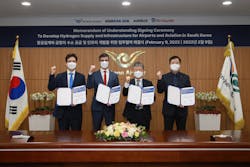Seoul's Incheon Airport to explore supporting hydrogen powered aircraft
SEOUL - Airbus, Air Liquide Korea, Korean Air and Incheon International Airport Corporation signed a Memorandum of Understanding (MOU) to explore the use of hydrogen at Seoul’s Incheon Airport.
The collaboration will also study the development of a Korean domestic airport infrastructure to support the deployment of hydrogen-powered commercial aircrafts. This partnership reflects a shared ambition to drive the emergence of an innovative aviation sector dedicated to supporting the Korean government's goal of carbon neutrality by 2050.
“In the coming years, the Korean aerospace ecosystem will have to adapt to new fuels and new distribution channels. Airbus and its partners need to be coordinated to ensure we will be ready,” Anand Stanley of Airbus President Asia-Pacific says. “Under the MOU Airbus will provide characteristics of hydrogen-powered aircraft ground operations, as well as aircraft characteristics and fleet energy usage. Together we will prepare a roadmap to first develop hydrogen usages at and around Incheon Airport and then build scenarios to support the deployment of hydrogen ecosystems connected to other Korean airports.”
The partnership will also focus on carrying out studies aimed at defining and developing the required liquid infrastructure at Incheon Airport to prepare the arrival of the first hydrogen-powered aircraft.
Each partner will leverage their complementary expertise to help define the potential opportunities that hydrogen offers, and support the decarbonization of the aviation industry. Air Liquide will bring its extensive expertise in mastering the entire hydrogen value chain (production, liquefaction, storage and distribution ), in particular liquid hydrogen supply while Korean Air will provide expertise on ground aircraft operations and aviation management and operations.
Finally, Incheon International Airport Corporation will provide an airport development plan outlook, along with air traffic characteristics and distribution among terminals.

